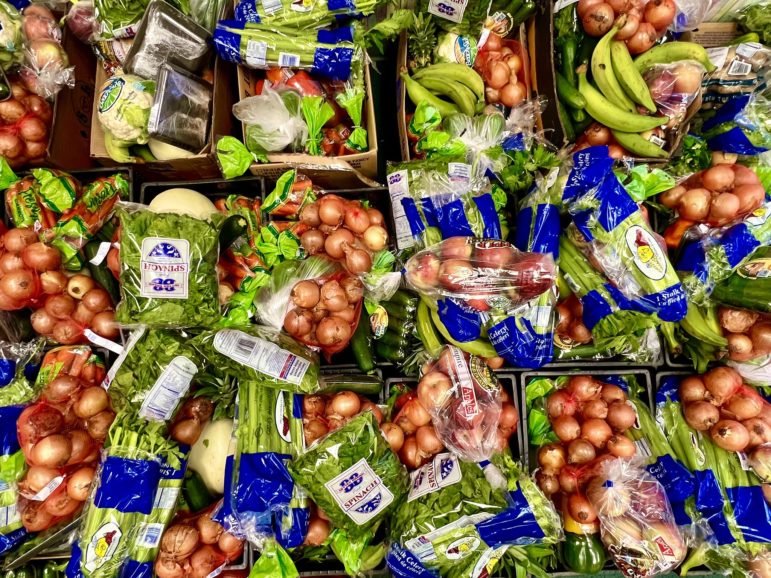“Even with stable housing, a well-paying job, and food security, diabetes mellitus can be difficult to manage. For New Yorkers who don’t know when their next meal will be or where they’ll sleep on any given night, managing diabetes can feel impossible.”

Michael Appleton/Mayoral Photography Office
Food at a nutrition-related announcement by the mayor’s office in February.When Steve first came to my primary care clinic, he had just been discharged from his third hospitalization in as many months for diabetic ketoacidosis (DKA), a serious complication of diabetes mellitus (DM). Although extremely motivated to control his DM and get his life back on track, living in a shelter, he told me, made this virtually impossible.
The food he was served was processed and filled with carbohydrates, he couldn’t always get his insulin and needles when he needed them, and he couldn’t afford to buy his own food during the day when not at the shelter. These issues caused Steve’s blood sugar to be uncontrolled, eventually leading to multiple hospitalizations.
Steve is not alone. Diabetes is one of the most common conditions in America, affecting 11.3 percent of the population, with 28.5 million adults who have been officially diagnosed and another approximately 8.5 million people undiagnosed. In 2019, DM was the seventh leading cause of death in America. Uncontrolled DM leads to severe complications including kidney disease, nerve damage, amputations, vision loss, strokes, and heart attacks. The mainstays of management include lifestyle modifications involving diet and exercise, regular blood tests, specialty medical appointments, plus medications if needed.
Even with stable housing, a well-paying job, and food security, DM can be difficult to manage. For New Yorkers who don’t know when their next meal will be or where they’ll sleep on any given night, managing diabetes can feel impossible.
New York City has more than 50,000 people staying in shelters per night, and that number has drastically increased during the pandemic. According to the American Diabetes Association, people with DM were 48 times more likely than people without DM to become homeless during the pandemic. In New York City Health and Hospitals, 5.2 percent of patients, or 43,230 people, are documented as homeless. Half have at least one chronic disease, and 21 percent have diabetes. In the last year, New Yorkers experiencing homelessness accounted for 122,604 emergency room visits and 20,497 inpatient stays. This is no surprise given how hard it can be for people experiencing homelessness to manage chronic conditions like diabetes.
One of the main barriers that New Yorkers living in shelters face when trying to control their diabetes is a lack of control over what and when they eat. It is very difficult to control DM without diet modifications. Of course, other issues abound, including access to medical care, ability to properly store medications and needles, and the financial burden of managing a chronic disease. While these issues require more systemic solutions, improving the quality of food in shelters is an effective place to start.
Mayor Adams is a passionate advocate for a plant-based diet, having reversed his own diabetes through lifestyle changes. On the campaign trail, Adams said, “You should not be in a homeless shelter where I am feeding you on taxpayers’ dime and I am feeding you food like chicken nuggets.” In February, he signed two executive orders including one that, for the first time in its 30-year history, ensures fresh fruit and vegetables will be delivered to 600 food pantries and soup kitchens via the city’s Food Distribution Program.
Still, although food and beverages served by city agencies are supposed to comply with the NYC food standards, which limit the amount of salt, sugar, and trans-fat contained in products, a 2018 audit suggests that there is not adequate oversight of the nutritional value of food served in shelters. More recently, patients and those working in shelters have shared that the food options in shelters are nutritionally subpar and do not allow people to control their blood sugar.
The financial implications of ignoring this issue are dire. People with diabetes tend to have medical costs 2.3 times higher than those without DM. In 2017, the cost of diabetes was $327 billion. While the city cut funding for the Department of Homeless Services by nearly 15 percent for FY23, the cost of medical complications arising from uncontrolled DM will eclipse these savings. We would be better off investing in preventative measures, like healthier food. And plant-based is not enough; people need high-quality food, not processed ready-meals.
We need to do more to support people with diabetes who are experiencing homelessness. While there are many local organizations that help with education and resources, local government needs to step up and provide more funding and infrastructure. Mayor Adams praises the power of a plant-based, whole-food diet for himself. Let’s hope that he funds and creates initiatives to bring it to the people, wherever they reside.
Dr. Sarah Goldhill is a medical resident living and working in Brooklyn.









2 thoughts on “Opinion: Our Homeless Shelters are Failing New Yorkers with Diabetes”
Hello. Shelter agencies can be very corrupt. Many get funding for job help but the management staff will buy computers for themselves. Many times the food is spoiled and will give you an upset stomach. They can Inc hotel fees per family to 8 K a month in fake services. You just get food most of which is high in Sodium.The longer you are there the homeless agency makes more$$. Voyerism from male staff a rampant problem. Many will hire dangerous ex cons with bad tempers and no skills.
People experiencing homelessness who have diabetes need more support. Your point is well taken and more funding and infrastructure are needed to help large numbers of people.